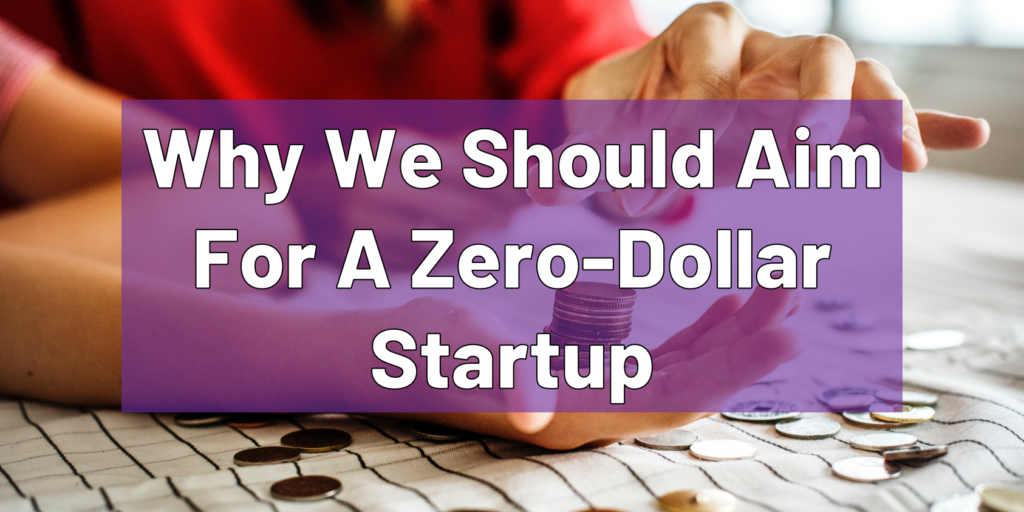But you need money to make money? Right?
Is it possible to start a business for nothing, or at least very cheaply?
A reason that many people hesitate at starting a business is the belief that they need a large reserve of money to get started. They need cash to fund all of the equipment, staff, advertising, branding, shop space, and product up front so they can begin selling as a “traditional” business. Also you need about 2 years worth of personal expenses saved because that is the average time it takes for a small business to become profitable (Freshbooks).
But why is that? Where did that belief come from? Is there another way?
At The Simple StartUp, we argue that businesses can be started with little to no expense for the owner. That you can acquire many of the things you “need” to get started really cheaply or for free, and what you actually need to get started is typically much less than you think. If you are starting with the Minimum Viable Product (MVP) version of your business, then you are looking for the most stripped down and bare bones version of your business idea. You can then use this to test out the idea, see what customers really want in terms of improvements, additional features, pricing, customer service, and so on.
The MVP for your business should require as little as possible to get started but should aim to bring in income. This income can then be used to grow your business to the next level, and then the next level, and so on. Typically, the MVP version of your business is not a full-time thing. You try it out while still working a full-time job, which eradicates or at least severely reduces the amount of reserves you need in place for the time when you decide to pursue it full-time. And that’s if you decide to go down that path at all. Some of the best businesses can be managed as side-hustles with a small amount of dedicated time each week.
When we think about the things we need to get the business started, that is where the fun part starts! Start with the big dream version of your business idea, which is probably what you came up with first. For example, “I want to run a bakery or a landscaping business”. They think about what the most basic version of this business might be. In the case of the bakery business, how about doing orders for cupcakes or cakes, that you make in your own home, and deliver to a customer in your area? I would assume that you have some of the tools needed to bake if that is an interest of yours, and if not, check out places like Goodwill, Craigslist, and Facebook marketplace for really cheap ones. Also, ask you neighbors if you can borrow theirs! Once you sell a few orders, you can then think about getting more pans and tins to increase your options or output. As you grow, you can add more and more options such as a website, a farmers market tent, a dedicated commercial space, etc. For the landscaping business, how about starting with a post on a local Facebook community group offering to mow lawns using the owner’s lawnmower? That’s it, you are going to show up with just yourself and mow the lawn. Maybe you bring a gas can, but that’s it. From there, you move up to a cheap push lawn mower that you found on Facebook Marketplace. Then you get a small trailer for your lawnmower to allow you to go farther to cut lawns, then a used ride-on lawnmower to increase your speed, then some extra tools for doing edging, cleaning up, and other perks.
In each case, the profits of the business from the MVP are used to fund the next level of the business. At no point is the founder putting tons of their own money into the business to try and skip to a higher level. That’s not to say that starting with money and entering your business at a higher level can’t work, but if you think about the learning experience, and figuring out if people really want what you are selling, wouldn’t it make more sense to learn that with a business that has cost you nothing but a little time, versus a business with lots of your money in it, or even worse, borrowed money!
Have you ever heard the saying “In for a penny, in for a pound”? It’s this irrational idea that you’ve already sunk money into an idea, so you may as well keep dumping money and effort into it, in the hope that it will eventually become profitable. Many entrepreneurs fall into this trap because the pressure to succeed is there. They need to become profitable to be able to pay back the borrowed money. They have employees who will be out of a job if they fail. They need to earn income to pay for their family’s needs. They don’t have another job or source of income to fall back on. Their reputation will suffer if it fails because they have gone all-in on this idea.
Having a zero-dollar startup means you are aiming to start the business for $0, or as close to it as possible. Using the strategies above, plus others that will be covered in future blog posts, we can remove the pressure for a business to succeed, and can instead build it slowly and purposefully. At each stage of our business we are testing out ideas, listening to the feedback of the customers, and making changes that we know will increase sales and satisfaction. We build the business that our customers want, rather than trying to make the customers come to the business idea we start with. The idea of “build it and they will come”, ends up being a high risk move, and by starting with a MVP version of your business, that has no risk involved, allows all the pressure to disappear. Failure is encouraged and embraced, because it is a chance to improve the idea OR to walk away before there is any significant amount of money invested.
I’d love to hear your thoughts and what your ideas are for starting a business for free! Please share them in our Simple StartUp Community or send me an email.


